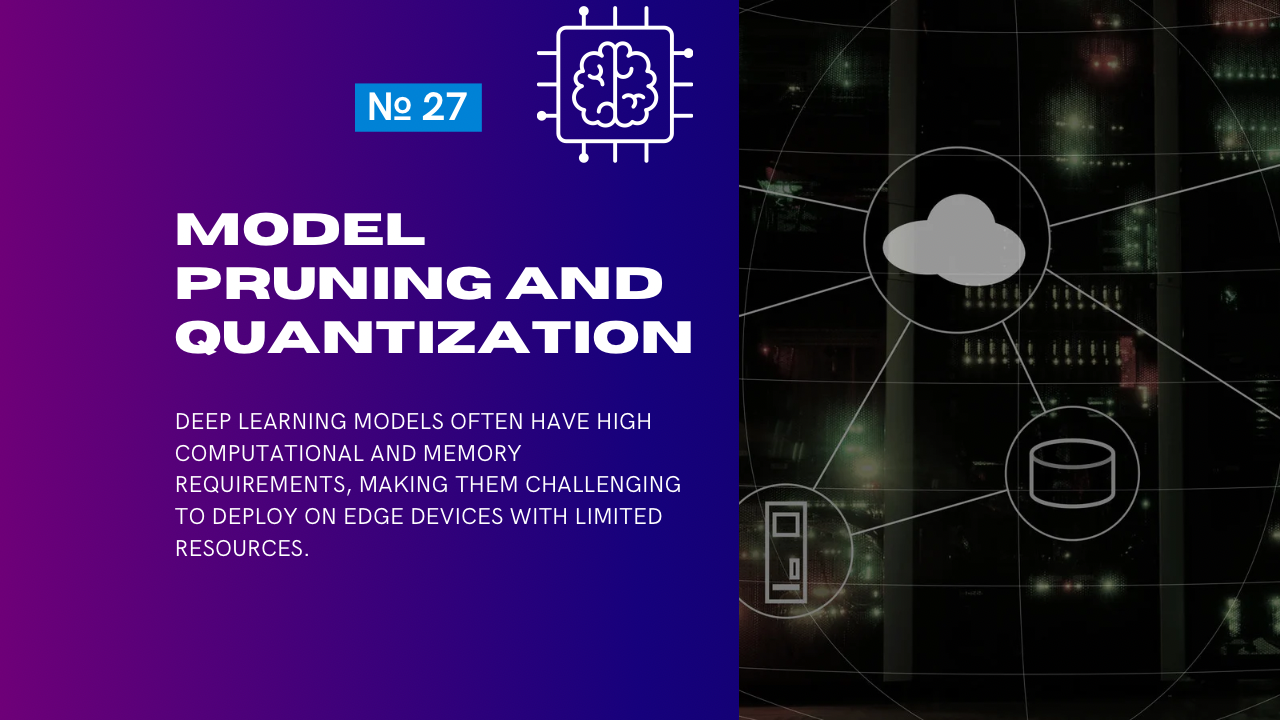Deep learning models often have high computational and memory requirements, making them challenging to deploy on edge devices with limited resources. Techniques like pruning and quantization optimize models for edge deployment by reducing their size and computational complexity while maintaining accuracy.
Why Optimize Models for Edge Devices?
- Resource Constraints:
- Edge devices (e.g., mobile phones, IoT devices, microcontrollers) have limited compute, memory, and energy.
- Real-Time Performance:
- Applications like real-time object detection or speech recognition demand low latency.
- Deployment at Scale:
- Smaller models reduce bandwidth costs and enable deployment to a large number of devices.
Key Techniques for Optimization
| Technique | Description | Purpose |
|---|---|---|
| Pruning | Removes less important weights, neurons, or layers from the model. | Reduces model size and computations. |
| Quantization | Reduces the precision of weights and activations (e.g., from 32-bit floating point to 8-bit). | Improves speed and memory efficiency. |
| Distillation | Trains a smaller “student” model to mimic a larger “teacher” model. | Compresses models with minimal accuracy loss. |
| Weight Clustering | Groups similar weights and replaces them with shared values. | Reduces memory footprint. |
1. Model Pruning
What is Pruning?
Pruning removes unnecessary parameters (weights or neurons) from a model to reduce its size and computation requirements.
Types of Pruning:
- Weight Pruning:
- Removes individual weights with low magnitude.
- Neuron Pruning:
- Removes entire neurons or filters from a layer.
- Structured Pruning:
- Removes groups of weights, such as entire rows, columns, or blocks.
- Dynamic Pruning:
- Applies pruning during model inference based on input data.
Implementation Example: Pruning with PyTorch
import torch
import torch.nn as nn
import torch.nn.utils.prune as prune
# Define a simple model
model = nn.Sequential(
nn.Linear(10, 20),
nn.ReLU(),
nn.Linear(20, 1)
)
# Apply pruning to the first layer
layer = model[0] # First Linear layer
prune.l1_unstructured(layer, name="weight", amount=0.5) # Remove 50% of weights
# Check pruned weights
print(layer.weight)
print("Sparsity:", torch.sum(layer.weight == 0).item() / layer.weight.numel())
# Remove pruning to make the model ready for inference
prune.remove(layer, 'weight')Advantages:
- Significant reduction in model size and computational cost.
- Applicable to both fully connected and convolutional layers.
Challenges:
- Aggressive pruning may degrade accuracy.
- Requires retraining or fine-tuning after pruning to recover performance.
2. Model Quantization
What is Quantization?
Quantization reduces the precision of model weights and activations, leading to smaller models and faster inference.
Types of Quantization:
- Post-Training Quantization (PTQ):
- Quantizes a pretrained model without additional training.
- Example: Convert weights from 32-bit floating-point (FP32) to 8-bit integers (INT8).
- Quantization-Aware Training (QAT):
- Simulates quantization during training to minimize accuracy loss.
- Dynamic Quantization:
- Quantizes weights at runtime while keeping activations in higher precision.
- Integer-Only Quantization:
- Ensures both weights and activations use integer arithmetic, ideal for hardware accelerators.
Implementation Example: Quantization with TensorFlow
import tensorflow as tf
# Load a pretrained model
model = tf.keras.applications.MobileNetV2(weights="imagenet")
# Apply post-training quantization
converter = tf.lite.TFLiteConverter.from_keras_model(model)
converter.optimizations = [tf.lite.Optimize.DEFAULT] # Enable default optimization (includes quantization)
# Convert the model
quantized_model = converter.convert()
# Save the quantized model
with open("mobilenet_v2_quantized.tflite", "wb") as f:
f.write(quantized_model)Implementation Example: Quantization with PyTorch
import torch
from torchvision.models import mobilenet_v2
# Load pretrained model
model = mobilenet_v2(pretrained=True)
model.eval()
# Apply dynamic quantization
quantized_model = torch.quantization.quantize_dynamic(
model, # Model to quantize
{torch.nn.Linear}, # Layers to quantize
dtype=torch.qint8 # Data type for quantization
)
print("Original model size:", model.state_dict().size())
print("Quantized model size:", quantized_model.state_dict().size())Advantages:
- Reduces model size and inference latency.
- Minimal accuracy loss with proper tuning.
- Compatible with hardware accelerators (e.g., TensorRT, Intel DL Boost).
Challenges:
- Some layers (e.g., custom operations) may not support quantization.
- Quantization-aware training requires additional effort.
3. Combining Pruning and Quantization
Pruning and quantization can be combined for greater efficiency. For example:
- Prune the model to reduce the number of parameters.
- Quantize the pruned model to further compress and accelerate it.
Comparison of Techniques
| Technique | Reduction in Size | Speed-Up | Accuracy Impact | Best Use Case |
|---|---|---|---|---|
| Pruning | Moderate to High | Moderate | Minimal if retrained | Reducing computational overhead. |
| Quantization | High | High | Minimal to moderate | Deploying models on edge devices. |
| Pruning + Quantization | Very High | Very High | Moderate (if aggressive) | Maximizing optimization for small devices. |
4. Deployment on Edge Devices
Hardware-Specific Optimizations
- NVIDIA TensorRT:
- Optimizes models for NVIDIA GPUs with mixed precision and INT8 inference.
- Edge TPU (Google Coral):
- Deploy quantized TensorFlow Lite models for ultra-fast inference.
- Intel OpenVINO:
- Converts models for optimized inference on Intel CPUs and VPUs.
Best Practices for Optimization
- Evaluate Baseline Performance:
- Measure accuracy and latency before optimization.
- Fine-Tune After Optimization:
- Retrain pruned or quantized models to recover performance.
- Profile Hardware:
- Use tools like NVIDIA Nsight, Intel VTune, or TensorFlow Lite benchmarks to evaluate performance.
- Iterative Optimization:
- Gradually prune and quantize to avoid excessive accuracy loss.
Case Study: MobileNetV2 Optimization for Edge
| Technique | Model Size (MB) | Inference Latency (ms) | Top-1 Accuracy (%) |
|---|---|---|---|
| Original (FP32) | 14.0 | 28 | 71.8 |
| Pruned | 7.5 | 18 | 70.5 |
| Quantized (INT8) | 3.5 | 12 | 70.0 |
| Pruned + Quantized | 3.0 | 10 | 69.8 |
Conclusion
Model Pruning and Quantization are essential techniques for deploying deep learning models on resource-constrained edge devices. While pruning reduces the number of parameters, quantization compresses model precision for faster and lighter inference. By combining these techniques and leveraging hardware-specific optimizations, developers can achieve high-performing models suitable for real-time edge applications.
